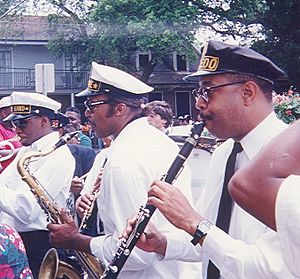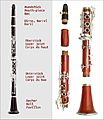Clarinet facts for kids
| Woodwind instrument | |
|---|---|
| Classification | Woodwind |
| Playing range | |
The clarinet is a woodwind instrument.
The clarinet has one reed. The reed is made of bamboo or plastic. The reed is attached to the mouthpiece with a clamp called a ligature, which is usually made out of metal. Blowing through the mouthpiece makes the reed vibrate, and therefore makes the noise. The body of the clarinet is a cylindrical tube with holes. The holes are covered by the fingers to make musical notes. There are also buttons pressed by the fingers which allow pads over holes to open or close so all notes of the chromatic scale can be played.
One kind of keyed clarinet is called the Albert system. Another kind is called the Boehm system. The Boehm clarinet is much used by classical orchestras and by jazz musicians. In North America and other Western countries, the most popular clarinet is the clarinet pitched in B flat. This means that if a clarinet player plays a note that is written as a C, it sounds like a B flat on a piano. The B flat clarinet is used in concert, marching, and school bands. Musicians in orchestras also play the A-clarinet (a semitone lower), the sopranino E flat clarinet (a fourth higher) and the Bass_clarinet in B flat (sounding an octave lower).
A beginner clarinet player usually can play a note within the first minutes of a lesson. Making a sound with the clarinet is easier than making a sound with many other wind instruments. Most instrumental music teachers consider it to be a good instrument for young players as soon as the lower adult teeth have grown. The fingering system is very similar to the flute and the saxophone, so changing from playing the clarinet to one of these instruments is not too difficult after the student is comfortable playing the clarinet and has reached a certain level.
A famous piece that features a clarinet is Wolfgang Amadeus Mozart's Clarinet Concerto, which has the clarinet playing the melody with the rest of the orchestra playing along. Written in 1791, it is often considered the first great composition for the instrument.
Extended family of clarinets
There is a family of many differently pitched clarinet types, some of which are very rare. The following are the most important sizes, from highest to lowest:
| Name | Key | Commentary | Range (concert) |
|---|---|---|---|
| Piccolo clarinet | A♭ | Now rare, used for Italian military music and some contemporary pieces for its sonority; |  |
| E♭ clarinet
(Sopranino clarinet in E♭) |
E♭ | It has a characteristically shrill timbre, and is used to great effect in the classical orchestra whenever a brighter, or sometimes a more rustic or comical sound is called for. Richard Strauss featured it as a solo instrument in his symphonic poem, Till Eulenspiegel. It is much used in the concert band repertoire where it helps out the piccolo flute in the higher register and is very compatible with other band instruments, especially those in B♭ and E♭. |  |
| D clarinet
(Sopranino clarinet in D) |
D | This was, to the high pitched E♭ instrument, what the A clarinet is to the B♭. Advances in playing technique and the instrument's mechanism meant that players could play parts for the D instrument on their E♭ thus making this instrument more and more expendable. Though a few early pieces were written for it, its repertoire is now very limited in Western music. Nonetheless Stravinsky included both the D and E♭ clarinets in his instrumentation for The Rite Of Spring |  |
| C Clarinet
(Soprano clarinet in C) |
C | Although this clarinet was very common in the instrument's earliest period, its use began to dwindle and by the second decade of the twentieth century it had become practically obsolete and disappeared from the orchestra. From the time of Mozart, many composers began to favour the mellower, lower pitched instruments and the timbre of the 'C' instrument may have been considered too bright. Also, to avoid having to carry an extra instrument which required another reed and mouthpiece, orchestral players preferred to play parts for this instrument on their B♭ clarinets, transposing up a tone. It is enjoying a resurgence in popular musical styles such as Klezmer; as an instrument in schools, and in more historically accurate interpretations of the classical and Romantic repertoire such as the First and Fifth Symphonies of Beethoven. |  |
| B♭ Clarinet
(Soprano clarinet in B♭) |
B♭ | The most common type: used in most styles of music. Usually the term clarinet on its own refers to this instrument. It was commonly used in early jazz and swing. This was the instrument of renowned and popular figures such as Sidney Bechet, Benny Goodman, Woody Herman and Artie Shaw. |  |
| 'A' Clarinet
(Soprano clarinet in A) |
A | Many clarinetists and some composers maintain this has a somewhat mellower sound than the B♭; most people can't perceive a difference in blindfold testing. It is frequently used in orchestral and chamber music, especially of the nineteenth century. The Clarinet Quintet by Brahms (op. 115) is a notable example. |  |
| Basset clarinet | A | Clarinet in A extended to a low C; used primarily to play Classical-era music. Mozart's Clarinet Concerto was written for this instrument, though it is frequently played in a version for the ordinary A clarinet. Basset clarinets in B♭ also exist; this instrument is required to play the obbligato to the aria "Parto, parto" in Mozart's La Clemenza di Tito. | |
| Basset-horn | F | Similar in appearance to the alto, but differs in that it is pitched in F, has an extended range to low C, and has a narrower bore on most models. Mozart's Clarinet Concerto was originally sketched out as a concerto for basset horn in G. Rarely used today. |  |
| Alto clarinet | E♭ or F | Sometimes referred to (mostly in Europe) as the tenor clarinet. Its greater size and consequently lower pitch give it a rich, dark sonority capable of greater resonance than the soprano instruments, but with less projection than the larger bass clarinet. It is used in chamber music and concert bands, and occasionally, if rarely, in orchestras. A few players have specialized in using the alto in jazz (e.g. Gianluigi Trovesi). The alto in F is considered obsolete. |  |
| Bass clarinet | B♭ or A | Invented in the 1770s it only became popular around a hundred years later when it contributed to the rich orchestral palettes of composers such as Wagner and the late Romantics. It has become a mainstay of the modern orchestra. Originally the third clarinet would double on bass but now most orchestras employ a specialist devoted principally to this instrument. It is used in concert bands, contemporary music, and enjoys, along with the B♭ clarinet, a considerable rôle in jazz. Eric Dolphy was one of its more remarkable exponents. The bass clarinet in A, which had a vogue among certain composers from the mid-19th to the mid-20th centuries, is now so rare as to usually be considered obsolete. |  |
| E♭ contrabass clarinet (also called Contraalto clarinet) | EE♭ | Used in clarinet choirs and is common in concert bands. |  |
| Contrabass clarinet (also called B♭ subcontrabass or double-bass clarinet) | BB♭ | Used in clarinet choirs and is common in concert bands. It is sometimes used in orchestras. Arnold Schoenberg calls for one in his Five Pieces for Orchestra. |  |
Images for kids
-
Bass clarinet, Basset horn, clarinets in D, B♭, A, High A♭ and E♭, basset clarinet in A
See also
 In Spanish: Clarinete para niños
In Spanish: Clarinete para niños










